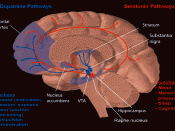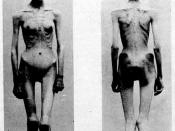As mentioned by Patricia Barry, eating disorder is defined as "a chronic disruption in one's ability to ingest food and derive nutrition from that food because of one or more emotional issues that lasts for 3 or more months." (Barry, 2002). Just as an alcoholic uses alcohol to cope, a person with an eating disorder can use eating, purging or restricting to deal with their problems. In the psychiatric setting, eating disorders are divided into two categories: Anorexia Nervosa and Bulimia Nervosa. These eating disorders are all identified and classified by DSM- IV or Diagnostic and Statistical Manual of Mental Disorders, 4th Edition. It is important to mention that obesity is not classified as a mental disorder in the DSM-IV but it is rather a factor resulting from a pert of bulimia disorder - binge eating.
A social issue that continues to cause concern for many teenagers is the problem of eating disorders.
Eating disorders come in a variety of ways, such as eating large quantities of food and obsessing with thinness. These conditions affect many children, teens, and adults around the world. They are real, complex, and devastating situations, which can have serious consequences. This is particularly worrisome as some teenagers are very vulnerable to such disorders. Eating disorders in many cases cause either extreme loss of weight or obesity as well as many health problems.
Anorexia NervosaAnorexia nervosa is an eating disorder that mostly occurs (about 59%) in adolescent girls, but it can also occur among teenage boys and adult men and women. Usually, anorexia begins between the ages of 14 to 18 when young teenagers go trough puberty (Ruuska et al., 2003). People with anorexia have an exaggerated fear of gaining weight, they tend to avoid high-calorie and carbohydrate food, and they often count calories.


